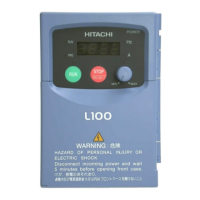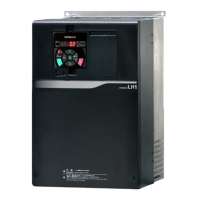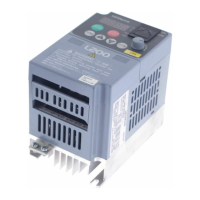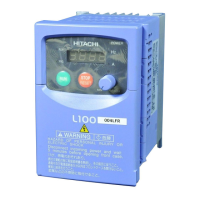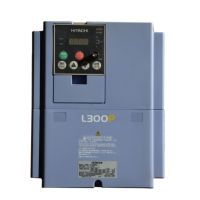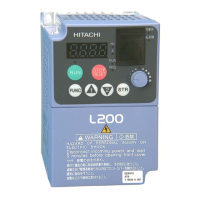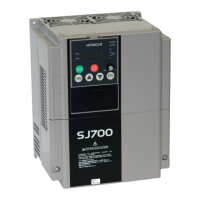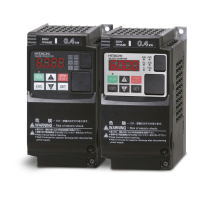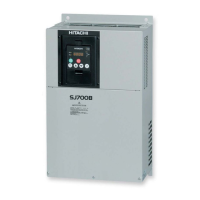Chapter 4 Explanation of Functions
4 - 89
4.2.93 Secondary resistance compensation (temperature compensation) function
The secondary resistance compensation function allows you to
compensate for the secondary resistance to control the motor speed
fluctuations due to the changes in the motor temperature. This function
can operate when the control mode is the sensorless vector control,
0Hz-range sensorless vector control, or vector control with sensor.
(Use the thermistor model PB-41E made by Shibaura Electronics Corporation.)
When using this function, specify "02" (NTC) for the thermistor for thermal protection control (b098). (With
a thermistor other than the PB-41E or another setting of the thermistor for thermal protection control, the
motor temperature cannot be detected correctly.)
Item Function code Data Description
Temperature compensation
thermistor enable
P025
00 Disabling the secondary resistance compensation
01 Enabling the secondary resistance compensation
4.2.94 Motor constants selection
Adjust the motor constant settings to the motor to be driven by the inverter.
When using a single inverter to drive multiple motors in the control mode based on VC, VP, or free V/f
characteristic, calculate the total capacity of the motors, and specify a value close to the total capacity for
the motor capacity selection (H003/H203).
When the automatic torque boost function is used, the motor constant settings that do not match the motor
may result in a reduced motor or unstable motor operation.
You can select the motor constants that are used when the control mode is the sensorless vector control,
0Hz-range sensorless vector control, or vector control with sensor from the following three types:
(1) Motor constants of Hitachi general-purpose motor
(2) Motor constants tuned by offline auto-tuning
(3) Arbitrarily set motor constants
The motor constants set for the 1st motor control apply to the 3rd motor control.
Item Function code Data or range of data Description
V/F characteristic
curve selection
A044/A244/
A344
00 Constant torque characteristic (VC)
01
Reduced-torque characteristic (1.7th power
of VP)
02 (*1) Free V/f characteristic
03 (*1) Sensorless vector control (SLV)
04 (*1) 0 Hz-range sensorless vector control
05 (*1) Vector control with sensor (V2)
Motor data
selection
H002/H202
00 Hitachi general-purpose motor constants
01 Motor constants tuned by auto-tuning
02 Motor constants tuned by online auto-tuning
Motor capacity H003/H203
0.2 to 90.0 (kW)
<0.2 to 160(kW)>
Note)<>applied for 90 to 160kW
Motor poles setting H004/H204 2, 4, 6, 8, or 10 (poles)
Motor constant R1 H020/H220 0.000 to 65.53 (Ω) (*2)
Motor constant R2 H021/H221
0.000 to 65.53 (Ω)
(*2)
Motor constant L H022/H222 0.00 to 655.3 (mH)
Motor constant Io H023/H223 0.00 to 655.3 (A) (*2)
Motor constant J H024/H224
0.001 to 9999. (kgm
2
)
(*3)
Auto constant R1 H030/H230 0.000 to 65.53 (Ω)
Auto constant R2 H031/H231 0.000 to 65.53 (Ω)
Auto constant L H032/H232 0.00 to 655.3 (mH)
Auto constant Io H033/H233 0.00 to 655.3 (A)
Auto constant J H034/H234
0.001 to 9999. (kgm
2
)
*1 Any of "00" to "05" can be selected for the 1st motor (A044). Only "00" to "04" can be selected for the
2nd motor (A244). Only "00" or "01" can be selected for the 3rd motor (A344).
*2 If you copy the data from a J300 series inverter to your L700 series inverter, set constants R1, R2, and
Io as follows:
R1
L700
= R1
J300
/1.125 R2
L700
= R2
J300
/1.2 Io = V/{272 x (2 x M
J300
+ L
J300
) x 10
-3
}
V: Voltage class (200 or 400 V)
P025: Temperature
compensation thermistor enable
b098: Thermistor for thermal
protection control
Related code

